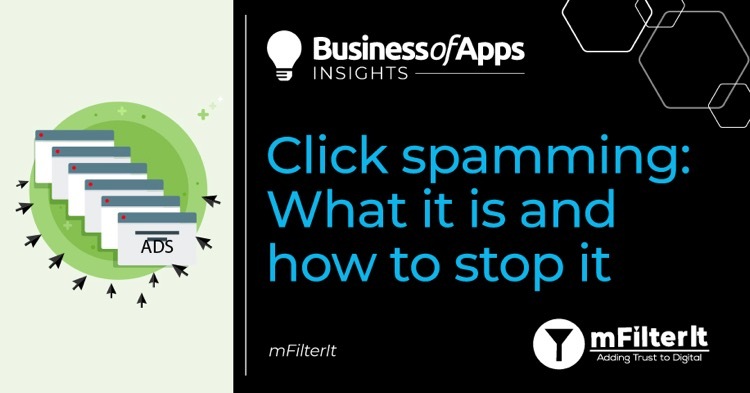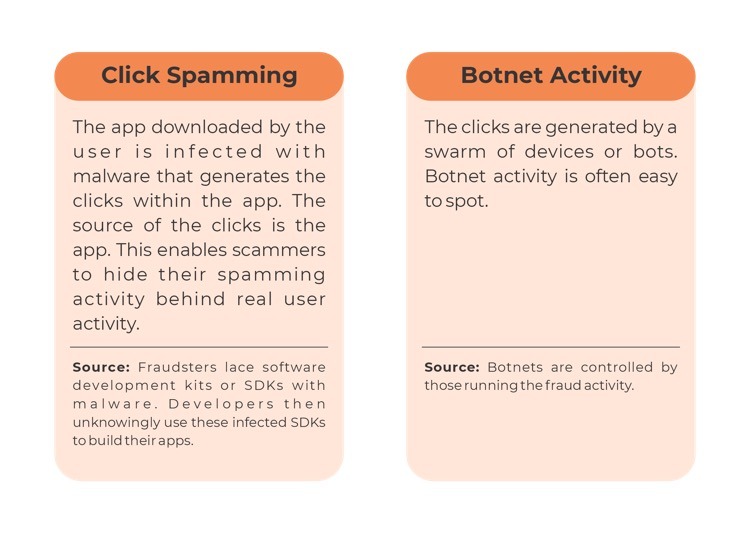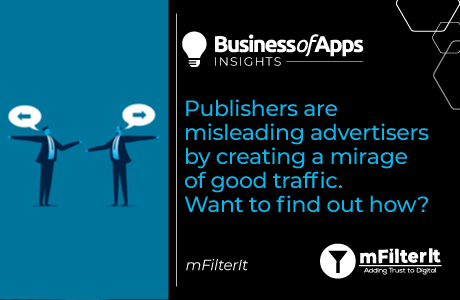While online fraud perhaps started with email spamming, it has come a long way. Today, ad fraud takes many forms, and it costs digital advertisers several billion dollars. The lure of making quick money has motivated modern fraudsters to employ sophisticated techniques to commit fraud.
Ad fraud techniques such as domain spoofing, cookie stuffing, ad stacking, ad injection, geo masking, and many others are just a few of the many techniques employed by modern fraudsters. Ad fraud is a serious problem that drains budgets and can cause long-term damage by skewing campaign performance data.
Awareness is the first step for any advertiser looking to protect their ad campaigns and the budgets associated with them. This article will help you build this awareness.
In the subsequent sections of this article, you will gain an in-depth understanding of one of the most prevalent click fraud techniques- click spamming.
Let’s dive right in:
What Is Click Spamming?
Click spamming is a click fraud technique that involves the generation of fake clicks on ads or app download links. With click spamming, the clicks generated often come from genuine devices with authentic devices and user IDs.
Click spamming can take many forms. Some of the most common ones are:
Click Flooding- Fraudsters generate several fake clicks on ads within an app.
Generating Fake Impressions- Fraudsters use a mobile app to generate fake views on videos in the background. The user is often unaware of this activity. In some cases, the app may place multiple ‘hidden’ ads within the ad interface and get credit for authentic impressions when a user views them.
Fire Up Your Growth!
Moburst propelled leading brands like Google, Reddit, and Uber to the next level. Let’s ignite your Success journey today!
Claim Your FREE Growth Fuel!Organic Poaching- Fraudsters use malware-laced apps to claim credit for authentic app downloads.
How does Click Spamming happen?
Click spamming activity usually happens in one of the following two ways:
Click flooding and generating fake impressions:
To execute this type of click fraud, the fraudster first places a utility app on the app download store. Examples of such apps may include a torch app, or a calculator. However, this activity is not limited to utility apps and has been observed in games and other types of apps.
Once a user has downloaded the app, it continues to run in the background. Without the knowledge of the user, the app’s in-built features generate automated clicks on ads.
Similar techniques are used to generate impressions and views.
Organic Poaching:
With organic poaching, the app downloaded by the user generates a number of clicks within the app. In some cases, it may be designed to enable an external device to click within the app. This goes on until the user downloads a promoted app or makes an in-app purchase. When they do, the credit is stolen by the fraudsters using organic poaching.
While the obvious impact of such click fraud activities is the lost ad budget, there is a deeper, more serious problem. Click fraud can distort advertisers’ analytics, compromising their ability to make informed decisions.
Access to data, the ability to test different ads and audiences, and the ability to optimize campaigns are perhaps the most pressing reasons to use digital advertising. Click fraud prevents advertisers from enjoying the full benefits of this access to data and associated benefits.
Difference between Click Spamming and botnet activity
Click spamming and botnet activity have a few similarities and are often confused with each other. Both involve generating a large number of clicks on mobile apps, mobile landing pages, and web pages. However, the key difference lies in the source of the clicks.
How to identify Click Spamming in your ad campaigns?
Click spamming can be difficult to detect. This is because the origin of the clicks is an authentic device with a genuine device ID.
That said, detecting click spamming isn’t impossible. If your ads are receiving a lot of traffic from a source, but the conversion rate is unusually low, it may be a sign of click spamming. To be sure, you can:
- Look into the publisher app. If the app does not have a lot of downloads but is generating a disproportionate number of clicks, consider it a red flag. It is also worth watching out for apps that haven’t been validated by Google’s Play Store. However, do you remember that there may be some genuine apps that have chosen to forego the validation process to protect their code?
- If you suspect a conversion, check the time between a click and a conversion. In most cases of organic poaching, fraudsters claim a conversion sometime after the click has been generated.
How to stop Click Spamming?
Once you have identified sources of fake clicks, you can simply block them. However, doing this at scale every day is often not practical or effective. Manually tracking click spamming activity can be time-consuming. Moreover, the process is prone to human errors that may lead you to overlook important sources of clicks. Similarly, in some cases, wrong judgment may lead advertisers to block genuine sources of authentic conversions.
The most reliable way to fight click spamming is to use an ad fraud solution like mFilterIt. mFilterIt uses its AI and ML capabilities to pinpoint verified instances of click spamming and also identify human-like traffic sources. This paints a transparent picture of your campaign performance and allows you to block sources of fraudulent traffic.
Conclusion
Click spamming is a serious fraud issue, but the unfortunate reality is that it is not the only one. Click fraud and other forms of online ad fraud are plaguing ad budgets and campaign reports. While this means that some advertisers will continue to struggle, for smart advertisers, this presents an opportunity to get ahead.
Think about it, simply by using an ad fraud prevention solution, like mFilterIt, you can improve campaign performance and the accuracy of your attributions.













